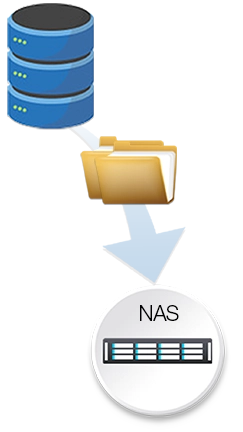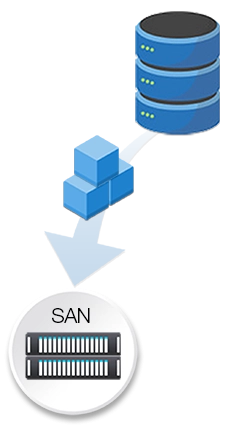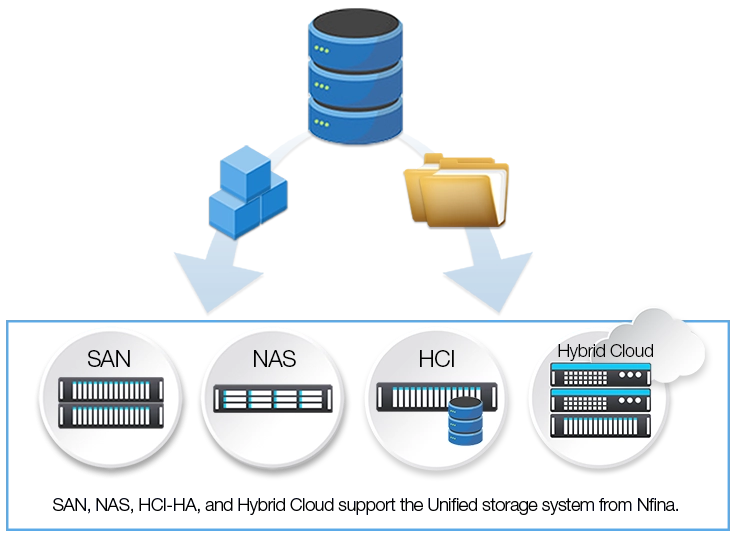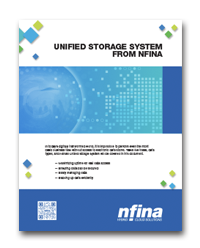A Unified Storage System from Nfina
Published: March 17, 2023
By: Julie Norman

Digital data is the most important asset for businesses that rely on their IT Ecosystem to function. In today’s digitally transformed world, it is impossible to perform even the most basic business tasks without access to electronic data stores. Maximizing uptime for fast data access, and ensuring the data can be secured, easily managed, and backed up, is the quintessential goal of all corporate IT organizations.
Digital Data Storage Types
The standard types of storage supported by Nfina are File and block storage.
File Storage
File storage (also known as file-level or file-based storage) is a hierarchical tree structure for storing digital data organized in files and nested folders. Typically shared file storage protocols used to access data over the standard ethernet LAN are NFS (Network File System), and SMB/CIFS (Server Message Block / Common Internet File System). The directory path of the file within the nested folder hierarchy is used to explicitly access the data from its stored location. The device that shares the file storage data over the LAN is typically referred to as a NAS (Network Attached Storage).

Block Storage
When using block storage, the storage system takes the digital data (files and databases, etc.), and divides it into fixed and independent equal-sized blocks. Each block of data is given a unique handle (identifier), and that identifier is stored in a lookup table. When data is requested, the storage system uses the look-up table to collect and re-assemble the blocks when presenting data back to the end user. When the block storage is located on the LAN, the ISCSI (Internet Small Computer Interface) transport protocol running over TCP/IP is typically used to access the data. Other ISCSI transport layers include RMDA, RoCE, Infiniband, and Fibre Channel. When forming a network using the typical network protocols to facilitate block storage transfer, the device is typically referred to as a SAN (Storage Area Network).

Unified Storage System from Nfina
The Unified Storage system from Nfina allows access to file and block storage types simultaneously. Nfina also extends this unified storage to its Hybrid Cloud offering. Unified storage uses standard file protocols such as SMB/CIFS and NFS, alongside standard block protocols like Fibre Channel and iSCSI. This allows users to consolidate all their storage needs into a single appliance or cluster instead of purchasing separate SAN and NAS devices. The advantages of a unified storage system are cost, scalability, and the ability to access and run all workloads at peak performance on a single converged or hyperconverged clustered storage system. All storage offerings from Nfina (SAN, NAS, HCI-HA, and Hybrid Cloud) support the Unified storage system from Nfina.

ZFS Storage System
All Nfina NAS and SAN storage systems utilize the ZFS file system. Therefore, the typical definition is SAN=Block Storage and NAS=File Storage, Nfina storage systems can serve up both block and file storage types simultaneously. This is because the underlying storage file system is ZFS (Zettabyte File System). ZFS was originally developed by Sun Microsystems in 2001 and was acquired by Oracle in 2010 and is now maintained as OpenZFS.
Nfina also offers an HCI (Hyperconverged Infrastructure) where the storage and compute are combined on the same platform. Like the SAN and NAS offerings from Nfina, our HCI platforms access data simultaneously using unified storage.
ZFS has many unique features and is known as copy-on-write technology. Instead of the traditional read-modify-write sequence, ZFS uses read-modify-create new block. This allows ZFS to be extremely efficient when it creates immutable snapshots (another built-in feature of ZFS). ZFS only has to collect the most recently written blocks created since the last snapshot from the lookup table and transmit those blocks to the backup pool (which could be located on the LAN or WAN). Since this is not a compute-intensive operation, this allows the creation of many high-frequency recovery points (i.e. every few minutes) that can be used to back up and restore data. ZFS snapshots work with both block storage LUNS (logical unit number) and SMB shares. These snapshots are the foundation for Nfina’s geo-redundant rapid disaster recovery solution that can restore data in minutes after a catastrophic failure event (i.e. power outage, Ransomware, etc).
When you work with Nfina, we will evaluate your IT business needs and choose the best data type and protocol setup, taking into consideration data management and administration, cost, hardware maintenance, scalability, and desired features.
References
https://www.ibm.com/topics/file-storage
https://www.ibm.com/topics/block-storage
https://aws.amazon.com/what-is/block-storage/
https://www.redhat.com/en/topics/data-storage/file-block-object-storage
https://www.suse.com/suse-defines/definition/file-storage/
https://www.datacore.com/blog/file-object-storage-differences/

At Nfina, our Eco-Friendly Solutions make it easy for our customers to achieve a lower carbon footprint and play a positive role in bringing about a sustainable future. We design technologies and products to help people understand their impact and actions better.
Nfina’s Hybrid Cloud and Hyperconverged solutions provide energy efficiency by using high-density, lower-power VMs enabling our customers to scale their digital transformations sustainably by optimizing space, reducing power consumption, and lowering cooling and maintenance costs. Nfina is taking a leadership role in doing what it takes to tackle climate change.
Nfina has been carbon neutral for our operations since opening in 2012.

